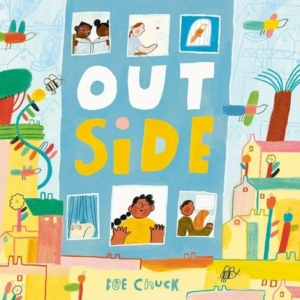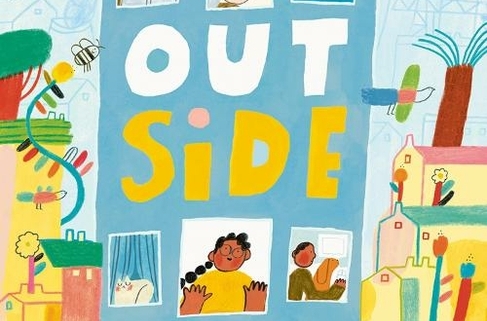Q&A with Bee Chuck
One of our committee members, Erin Hamilton, was offered the opportunity to read Outside by Bee Chuck and to send some questions along to the author-illustrator. It may prompt you to remember those first weeks of lockdowns with a new perspective.

Bee, what a stunning story! As a family, we completely identify with the families in the book. My own children were excited to spend more time at home, miss school and didn’t miss outside until weeks later. I loved watching the news reports of animals and nature taking control again, especially the dolphins in the canals of Venice. I think this special book will help children identify with their own experiences.
This is a beautiful take on what the world encountered in lockdown. Was this similar to your own experiences during this time?
I actually had a lot of struggles with my mental health during lockdown but there were so many moments of connection and hope which inspired this book. One of the happiest moments I had in lockdown was when I went for a walk in the woods near my house in Leeds. I could hear a woodpecker in the trees and it took me ages to spot it but when I did I stood on the path watching it. And every now and then someone walking past would ask me if I could see the woodpecker, and then we’d stand and watch it together. I must have stood there for almost an hour just watching this woodpecker and chatting to people about it, but this was one of the moments that inspired Outside; I wanted to write a story that gave people the same feeling that I had when I was watching that woodpecker.
How easily did you find the story to write, recalling the long days, the longing for contact and nature?
I think there were definitely elements of this book that were hard to write about, being inside an isolated for such a long time was hard on so many people. One of the happiest things I remember hearing about in lockdown were all the stories of rewilding; the un-mowed road verges erupting into wildflower havens, the sheep playing on the playground roundabouts in Monmouthshire, the wild white stork chicks hatching in Sussex for the first time since 1416. So my favourite parts of writing this book was when I was recalling small and beautiful moments like this that bought hope and happiness into the long days of isolation.
What do you hope the world will do with nature now we are allowed outside?
I hope that the world starts to recognise just how important nature is to our mental health and that by encouraging rewilding and biodiversity we are also supporting ourselves. I hope that people feel encouraged to nurture ecosystems within cities, and to see and nurture themselves as a part of that ecosystem; humans also need to be nurtured, encouraged and cared for.
The illustrations are wonderful and I love the movement from dirty city in the car to nature filled city on a bike- did these take a long time to create?
The longest part of my process is actually usually the development stage, before I even started on any of the final pieces that you see in the book I created pages and pages of small mock up versions of each page to find the perfect colour palette and medium. My studio is absolutely full of piles and folders of paper covered with thousands of tiny picture book pages in all different colours and mediums. But when it comes to painting a final piece I try not to spend more than a couple of days on one piece from start to finish as I want to capture the playfulness and spontaneity from those rough development artworks.
What is your chosen medium as an illustrator?
My working process involves a lot of scribbling and paint sploshing. I work with a mixture of gouache, pencil and collage and my desk is always messy with pencils, jars of paint water and little pebbles, leaves and flowers that I’ve collected. I love to create hand rendered artwork because I feel more connected to the piece, and there’s more space to play and experiment in the same way that children do when they’re creating artwork. My favourite art of all time is children’s drawings and I want to reflect the freedom and silliness of that in my work; sometimes I’ll lie on the floor scribbling in my sketchbook with piles of paper and pencils and paints sprawled out around me and I’ll feel like a child again.
Do you find that words or pictures come more easily to you?
Normally it’s the story that comes to me first, I love going for long hikes in the Yorkshire dales or along the coast path and making up stories for myself as I walk. Sometimes these story seeds start to grow in my mind and I start to imagine what the characters would look like, but it’s definitely the magic of drawing out the characters and worlds and seeing them visually that really brings a story to life for me. Often the drawings themselves actually change and shape the story itself; the pictures help me choose the words.
What do you hope children and adults will learn from Outside?
I really wanted people to get a sense of how important nature can be to our wellbeing as humans, and the beautiful symbiosis that happens when we allow nature to re–wild city spaces. Free play in nature is proven to support children’s cognitive development and mental wellbeing and I hope Outside can help to remind people how lovely it is to play and explore in nature, even if it’s just scattering some seeds for the birds or drawing a picture of a ladybird you found on your windowsill.




